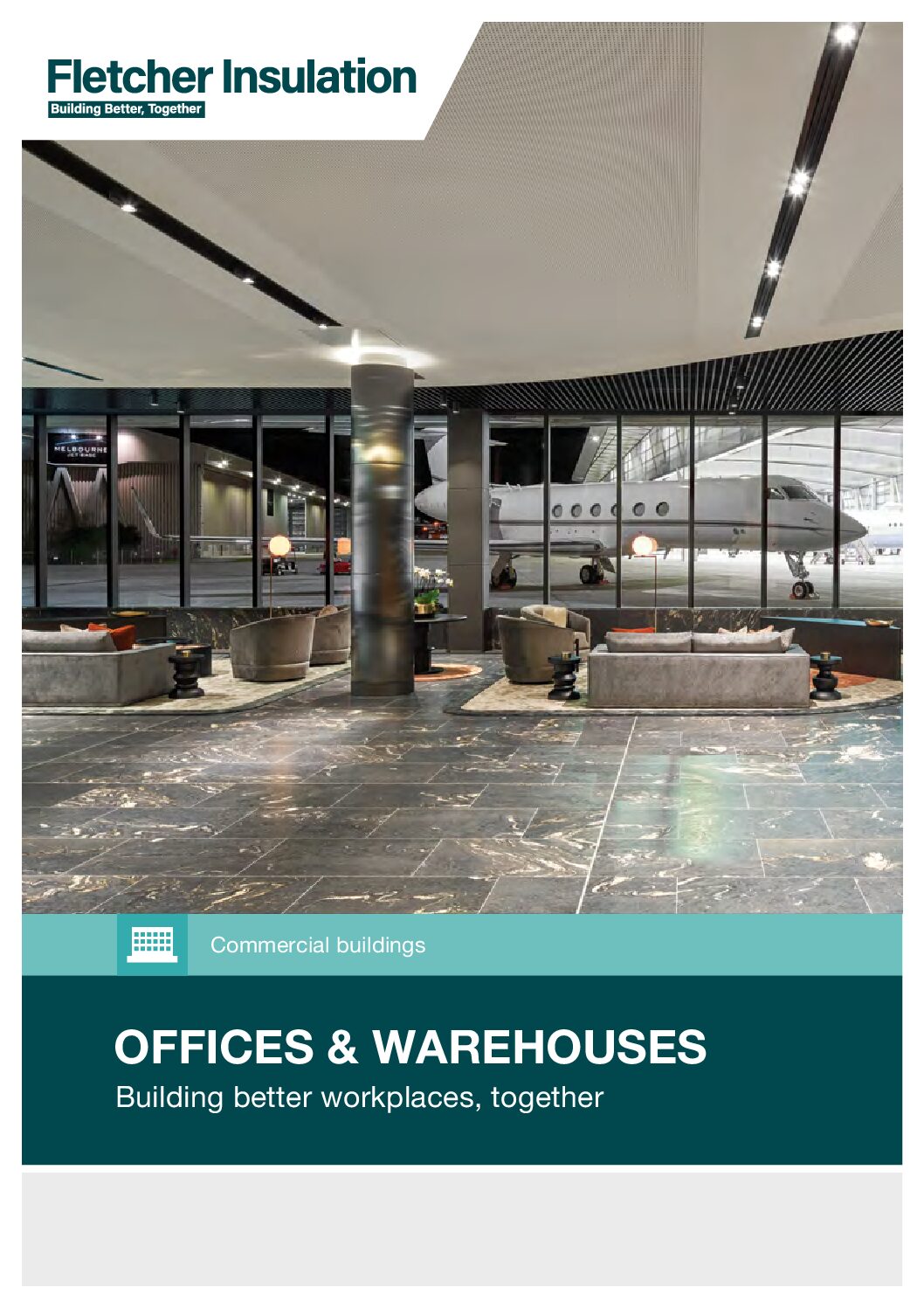Offices & Warehouses
Shaping sustainable, healthy, and comfortable workplace environments
People spend half their waking hours at work. So, it makes sense that workplaces providing thermal and acoustic comfort to support the wellbeing of workers, are more productive workplaces.
These days, smart workplace design is evidenced-based. As well as incorporating appealing aesthetics, designers can now create an environment that supports increased productivity based on well-researched design principles.
Drawing from our range of sustainable insulation materials – in walls and ceilings, under floors and roofs, around building services, and in and around the HVAC – we help designers build more comfortable workplace environments.
How insulation helps to create better workplace environments
Thermal and indoor air quality (IEQ) have been identified as the two most important aspects of the built environment that have an impact on people working in offices.1 Insulation is a key contributor to improving both.
By selecting the optimal acoustic insulation materials, designers not only reduce noise disturbance, but they also help reduce stress, distraction, and low performance in the workplace.2
A nation-wide survey of 1,719 Australian workers found that three quarters had experienced heat stress at work and 10% were intending on quitting their jobs because of it.3 Insulation is an effective way of managing the indoor climate of Australian workplaces, helping to maintain the comfort level of workers.
At Fletcher Insulation we’ll help you specify the optimal insulation materials for use in your office and warehouse building projects.
We provide solutions that contribute to creating:
- a healthier indoor environment for people at work
- reduced energy solutions to control costs and environmental impact
- higher Green-Star ratings and WELL certification
- safe, fire-resistant construction systems
Taking a holistic approach to the health and wellbeing of people working in offices and warehouses
The conditions in most office environments compared to those found in a typical warehouse vary considerably. But what they have in common is the need to support the people who work in them.
According to research4, both cold and hot temperatures increase the risk of work-related injuries and illnesses. In extreme conditions thermal discomfort can result in adverse behavioural effects, such as disorientation, impaired judgement, loss of concentration, reduced vigilance, carelessness, and fatigue. Chronic conditions such as respiratory diseases and skin diseases can also be exacerbated by factors associated with extreme temperatures.
In both office and warehouse environments, a comfortable indoor temperature is often regulated by air conditioning. Building and HVAC insulation is a proven way of increasing the efficiency of both cooling and heating systems. In unconditioned warehouses, thermal and acoustic insulation plays an important role in protecting the building from radiant heat and unwanted noise.
The importance of acoustic comfort
To create the best conditions for people to work in, all workplaces should be designed for people’s acoustic comfort.
As the popularity of open-plan offices increased, it became clear that this type of office design led to unacceptable levels of background noise.2 Continually being exposed to irrelevant and unintelligible conversations caused people to become distracted, leading to a decrease in productivity. A lack of privacy was also an issue.
The increasing use of audio and video conferencing has also presented challenges within an office. It’s important that a comfortable acoustic environment supports clear and comfortable communication without interfering with others in the workspace.
The installation of ceiling insulation, along with privacy and acoustic panels, was shown to significantly improve speech intelligibility and communication within an office environment.5
Noise from external sources and from machinery plus from other internally generated noise and vibration, can present health and safety risks for workers. As well as being a threat to their hearing, the presence of excessive noise may mean they’re unable to hear instructions and warnings or hear oncoming machinery or vehicles. While wearing personal protective equipment (PPE) is recommended, workers in a more industrial setting also benefit from the acoustic absorption and noise isolation that insulation offers.6
Fletcher Insulation products are designed on the principal that quality acoustic design supports the health and wellbeing of all people in our community.
Controlling indoor thermal comfort, air quality and building condensation
As well as wanting to create a highly productive work environment, Australian employers have a duty of care to look after their employees.
A well-managed indoor environment supports the wellbeing of its occupants. A workplace that’s thermally comfortable and has a healthy indoor air quality helps workers focus their energy on work rather than coping with adverse environmental conditions.
The key to Fletcher Insulation’s approach is to devise a tailored solution for each office, warehouse, and multi-use building project.
We offer a range of insulation solutions that help reduce reliance on artificial cooling and heating systems and improve indoor air quality.
Working with some of the country’s leading commercial building designers, we’ve supplied products for many offices and warehouse projects.
Protecting people and buildings from fire
Fire-safe workplaces protect both people and property. Designing a building to be fire-resilient means considering the needs of the people who use it every day. For designers of offices and warehouses, it means selecting building materials that will help keep people safe.
The use of passive fire protection strategies protects a building’s occupants should a fire break out in their workplace. It’s also a best practice approach to mitigating property and equipment damage, and minimising interruption to an organisation’s operation.
Insulation installed in external and internal walls, floors, ceilings, roofs, and around HVAC applications, is an integral part of fire safety control within any commercial building.
As well as National Construction Code (NCC 2019 and 2022) compliance, designers and commercial building owners must also consider the standards and minimum requirements of insurers. Choosing insulation that fails to meet these specifications could mean higher insurance premiums.
Fletcher Insulation has developed a range of rigorously tested insulation solutions. Made of sustainable, non-combustible or low flammability materials, our products are designed to keep people and buildings safe. Whatever the specific challenge of your building design, our expert team is on-hand to help designers and specifiers select the best fire-safe solution for your building project.
Using Fletcher Insulation’s glasswool products in external cladding and internal partition applications ensures your building complies with AS/NZS 1530.1 for combustibility.
For the good of the planet
As the importance of sustainable practices continues to grow, businesses are seeking ways to reduce their environmental impact. This is why our selection of energy-efficient solutions not only aligns with the ecological goals of architects and designers, but also complements their vision for creating sustainable office spaces, warehouse, and multi-use commercial buildings.
Furthermore, it provides peace of mind to know that Fletcher Insulation remains committed to investing in sustainable manufacturing processes by:
- making insulation with zero Ozone Depletion Potential (ODP).
- ensuring our insulation products support healthy indoor air quality and contain no harmful levels of Volatile Organic Compounds (VOCs)
- using recycled materials in our manufacturing process wherever possible – up to 80% of the glass used in our glasswool insulation is recycled, transforming a waste product and avoiding landfill.
References are listed in our Offices and Warehouses brochure.















